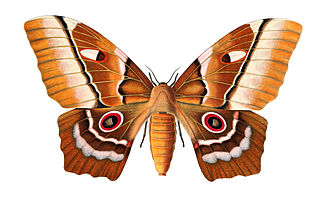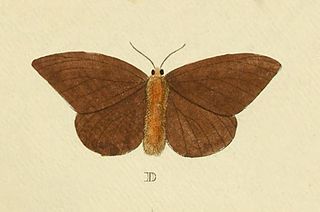
Saturniidae, members of which are commonly named the saturniids, is a family of Lepidoptera with an estimated 2,300 described species. The family contains some of the largest species of moths in the world. Notable members include the emperor moths, royal moths, and giant silk moths.

Actias sinensis, the Golden moon moth, is a moth of the Family Saturniidae. It is found in China, Taiwan, Vietnam, Myanmar, India and Thailand. The species was first described by Francis Walker in 1855.

The Saturniinae or saturniines are a subfamily of the family Saturniidae, also known as giant silkmoths. They are commonly known as emperor moths or wild silk moths. They are easily spotted by the eyespots on the upper surface of their wings. Some exhibit realistic eye-like markings, whilst others have adapted the eyespots to form crescent moon or angular shapes or have lost their wing scales to create transparent windows. They are medium to very large moths, with adult wingspans ranging from 7.5 to 15 cm, in some cases even more. They consist of some of the largest sized Lepidoptera, such as the luna moth, atlas moth, and many more. The Saturniinae is an important source of wild silk and human food in many different cultures.

Antheraea godmani is a moth of the family Saturniidae first described by Herbert Druce in 1892. It is found from Mexico to Colombia.

Pseudimbrasia is a monotypic moth genus in the family Saturniidae described by Pierre Claude Rougeot in 1962. Its only species, Pseudimbrasia deyrollei, described by James Thomson in 1858, is found in the mid-latitudes of Africa.

Hylesia is a genus of moths in the family Saturniidae. The genus was erected by Jacob Hübner in 1820.

Automeris is a genus of moths in the family Saturniidae and the subfamily Hemileucinae. As of 1996 there were 124 species, and more have since been described. These moths are generally characterized by the eyelike patches on the hindwings and the leaflike pattern on the forewings, an example of crypsis. The genus was first described by Jacob Hübner in 1819 and it is distributed in the Neotropical realm.

Dirphiopsis is a genus of moths in the family Saturniidae first described by Eugène Louis Bouvier in 1928.
Meroleucoides is a genus of moths in the family Saturniidae first described by Charles Duncan Michener in 1949.

Paradirphia is a genus of moths in the family Saturniidae first described by Charles Duncan Michener in 1949.

Copaxa is a genus of moths in the family Saturniidae first described by Francis Walker in 1855.

Urota is a monotypic moth genus in the family Saturniidae erected by John O. Westwood in 1849. Its single species, Urota sinope, was described by the same author in the same year. It was described from KwaZulu-Natal, South Africa.

Copaxa decrescens is a species of moth in the family Saturniidae first described by Francis Walker in 1855. It is widespread in Central and South America at low to medium altitudes.

Copaxa cydippe is a species of moth in the family Saturniidae first described by Herbert Druce in 1894. It is found in Central America, including Mexico and Guatemala.

Copaxa curvilinea is a species of moth in the family Saturniidae first described by William Schaus in 1912. It is found in Central America, including Nicaragua and Costa Rica.

Copaxa lavendera is a species of moth in the family Saturniidae first described by John O. Westwood in 1854. It is found from Mexico to Honduras. It has been spotted in the Netherlands on multiple occasions, where it was imported on plants.

Rothschildia orizaba, the Orizaba silkmoth, is a moth in the family Saturniidae. The species was first described by John O. Westwood in 1854. It is found in Mexico, Central and South America.

Copaxa denhezi is a species of moth in the Saturniidae family. It was first described in 1971 by Claude Lemaire and is found in Colombia.
















